Infant and Toddler Program
Toddlers Diving into Fall
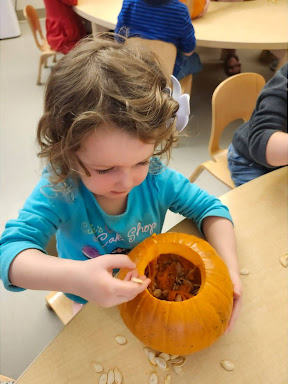
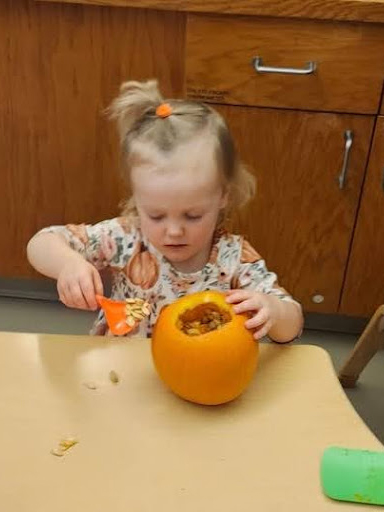

Several of the toddler rooms are using the changing of the seasons to explore what life looks like outside during the fall. The teachers are applying emergent curriculum by weaving together the children’s interest in the fall along with practice in different developmental domains. One toddler class started a provocation with pumpkins. The children took part in helping to carve pumpkins and empty the insides. They used their fine motor skills to manipulate tools in their exploration. They also scooped out the insides with their hands, which was a sensory experience that some children embraced more than others! Children used mathematical skills, making comparisons as they talked about how all of the pumpkins were similar and different. Later, the children’s language skills and enthusiasm were on display as they described to others how they cut the pumpkins and scooped out the seeds with tools and their hands. The children were very proud of their work!
Using Neighborhood Walks to Foster Development in Infants
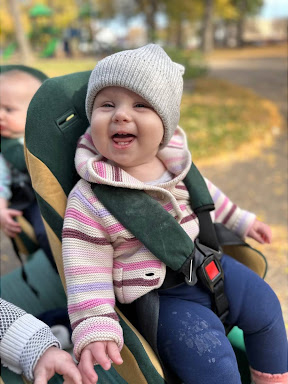
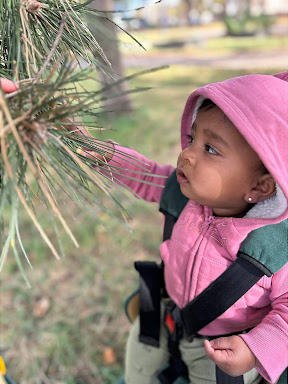

Taking infants on cart rides through the neighborhood may seem like a nice thing to do but perhaps without educational depth. In fact, neighborhood walks offer countless opportunities to foster development. Language emergence, social-emotional skills, environmental awareness, and motor development are a few examples of how walks support learning. On a recent walk, one of the goals was to expose infants to fall sights and sounds. The intentionality of the experience involved examining several different kinds of trees, where children were invited to feel different textures and notice the shapes and colors. Teachers used specific language that supported the exploration’s goals.
Socially, children engaged both with each other and with people they encountered—smiling, talking, and waving to people along the way. Several children spent a lot of time watching and imitating each other, a wonderful experience for relationship-building as part of social-emotional development. Using walks as opportunities for assessment, teachers were able to note the children’s gaze (what are they looking at while they were both moving and stationary), as well as how the children used their hands and fingers for both touching and waving (motor development). We encourage you to take walks with your children of all ages and in all kinds of weather and seasons!
—Becky Hegstad
Director, Infant and Toddler Program
Preschool Program
New Ramp Discoveries
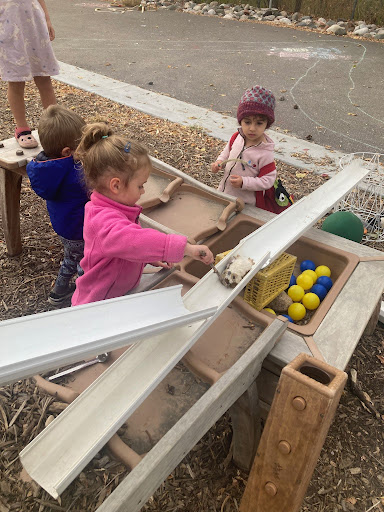
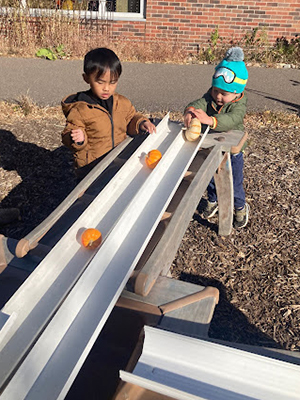
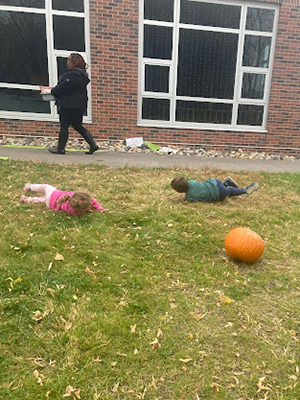
Since we added the open-ended ramp making materials, the children have been arranging and rearranging them in ways that allow them to refine their thinking about how they work. Some of their explorations included finding alternate objects to roll down the ramps such as rocks, gourds, and even stuffed animals (the stuffed animals were having fun going down “slides”). They noticed the difference in weight between the rocks and gourds and the hollow balls they had been using. The children experimented with creating tunnels and positioning baskets to catch the objects they sent down the ramps. They learned that they could move objects that got stuck by increasing the force acting on them (pushing objects with a hand or a tool) or by giving the ramp a steeper incline. All that rolling led to pushing a big pumpkin down a hill, after which the children decided to roll down, too!
—Amy Betz, Willow Room
Pumpkins
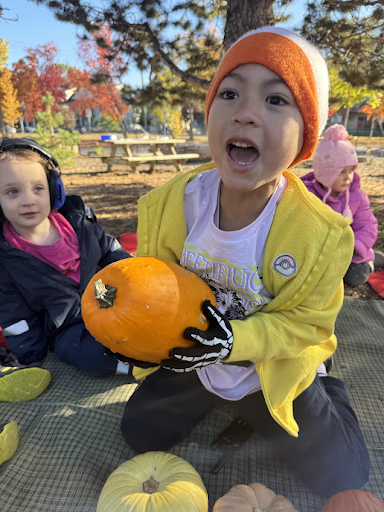
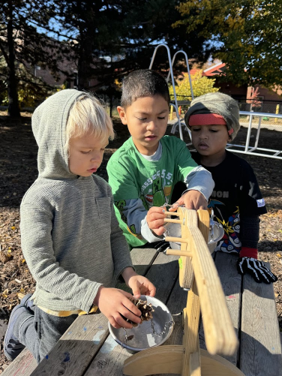
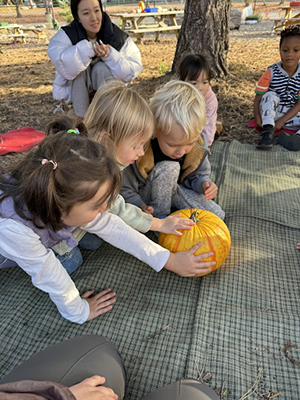
Pumpkins have been the center of many activities as of late. Our explorations started at large group where we made observations about five different pumpkins and put them in order from large to small. A few of the pumpkins were tricky to order which led to great conversations about size, width, and height. The children also noticed that the Cinderella pumpkin was much heavier than the pie pumpkin.
Next, we introduced a greater variety of pumpkins along with journals, observing the pumpkins, drawing them, and noting how they were different from our ideas about pumpkins as none of them were only orange. The children spent time drawing pictures of the pumpkins in their journals. To give children another opportunity to compare pumpkins and other natural materials, we introduced a balance on the playground. The children loved exploring how the balance worked and tried to figure out which pumpkins were the heaviest. They noticed that the striped pumpkins were particularly heavy. We also started painting pumpkins. Many children noted that different bumps and ridges on the pumpkins. While painting, children explored color mixing, trying to create the perfect shade for their pumpkins.
–Alyssa Wilt, Tamarack Room
Nature Arrangements
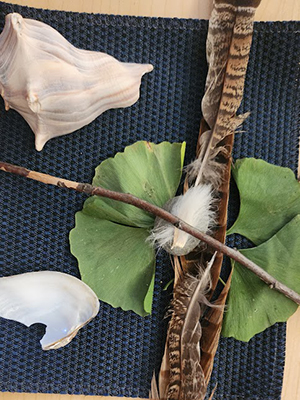
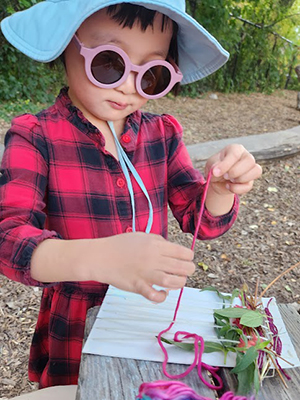
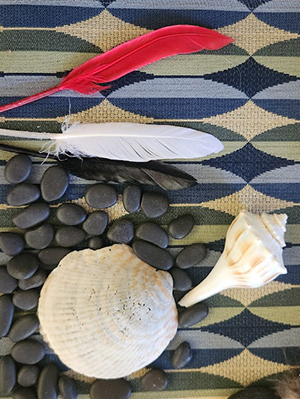
Children in the Hawthorn Room have been making beautiful nature arrangements, collages, and weavings.


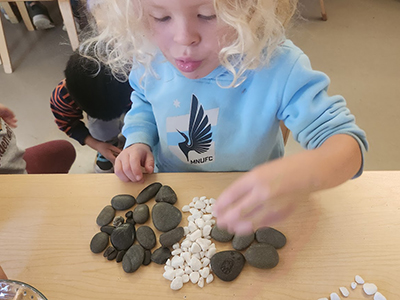
—Mandy Sumwalt, Hawthorne Room
Dakhódiapi Wahóȟpi | Dakota Language Nest
Planting Wild Rice in Bdé Psíŋ
This fall, the Dakóta iápi wahóȟpi took a field trip to Bdé Psíŋ, also known as Lake Hiawatha. Bdé Psíŋ is the original name of the lake and translates from the Dakota language meaning “Wild Rice Lake.” Before colonization, this lake and many others throughout the region were full of wild rice. Traditionally, one of the fall activities for Dakota was to harvest wild rice. Although it would be great to experience this in person, we would have to travel two hours up north in order to find the wild rice that still grows in the lakes. As much as we would love to have had that experience, we did the next best thing. We planted wild rice back into the lake!
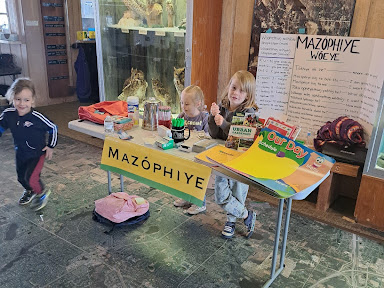
We partnered with teachers and students from Center School. Together, we started out with smudge, a hand drum song, and the children from the Dakhódiapi Wahóȟpi sang “Wóčhekiya Odówaŋ.” Next, everyone offered traditional tobacco and prayer with thoughtful intention about returning rice to the lake. Then, the Nest students and Center School students got into pairs to work together. They were shown how to make “rice balls” which are made from mud from the lake and rice seeds that were purchased. They then took a short walk along the shore to find a favorable spot for planting. They found a spot where the water was still and not too many cattails were growing. That’s where they gently tossed the rice balls into the water. When they were done they returned to wash their hands. Before they were done, some students were able to put Native clams into the lake. They learned that clams clean the lake water. Lastly, everyone gathered in a circle to sing a Dakota thank you song. The children enjoyed walking to the nearby park and then eating lunch at the picnic area before heading back to CDLS.
